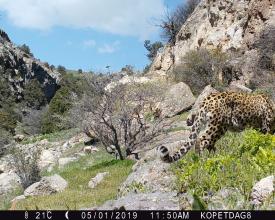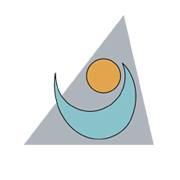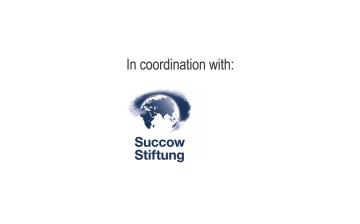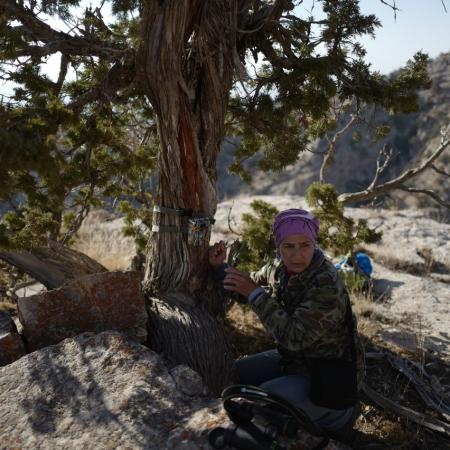
Uso de cámaras trampa para restaurar la conectividad de los gatos salvajes en Asia Central
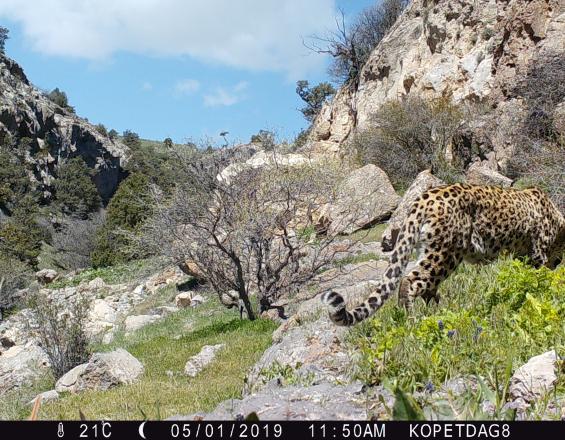
Situada en la parte central de la cordillera de Kopetdag, en la provincia turkmena de Ahal, y con una superficie de 497 km2, la Reserva de Kopet Dag Central incorpora dos santuarios y dos monumentos naturales.
Esta Reserva es el reducto más importante de Turkmenistán para la conservación del leopardo persa(Panthera pardus saxicolor) y recientemente se ha redescubierto la presencia del gato de Pallas(Otocolubus manul) , un pequeño felino salvaje relativamente raro. La Reserva es la puerta de entrada del leopardo persa entre Irán y las zonas situadas al norte y al oeste, en Kazajistán. Desde 2018, gracias a la colaboración entre el personal del área protegida y los socios internacionales, se está llevando a cabo un esfuerzo para establecer información de referencia sobre todas las especies de felinos, el estado de sus importantes presas (la cabra Urial y Bezoar), e identificar las amenazas, incluidos los impactos de la valla fronteriza con Irán. Se han desplegado veinte cámaras trampa que hasta la fecha han permitido identificar a varios leopardos persas, así como registrar al gato Pallas.
Contexto
Défis à relever
Al igual que otras áreas protegidas de Turkmenistán, la Reserva Central de Kopet Dag adolece de falta de recursos, financieros y técnicos, y de mayores oportunidades para que el personal desarrolle sus habilidades y conocimientos.
El otro gran problema es que la mayor parte de la Reserva se encuentra en la zona fronteriza, lo que dificulta el acceso regular del personal de la Reserva para realizar labores de vigilancia y patrullaje.
Ubicación
Procesar
Resumen del proceso
Los datos generados a través del seguimiento pueden ser una poderosa herramienta de comunicación y sensibilización que permita crear puentes entre las áreas protegidas y las comunidades locales. Las comunidades locales pueden entonces incluirse a través de un enfoque de "ciencia ciudadana" en el que los miembros de las comunidades se sientan capacitados por el mero hecho de aportar información importante al personal del área protegida.
Bloques de construcción
Seguimiento con cámaras trampa
Las cámaras trampa han revolucionado la investigación y la conservación de la fauna salvaje, permitiendo a los científicos recoger pruebas fotográficas de especies poco vistas y a menudo en peligro de extinción, con poco gasto, relativa facilidad y mínimas molestias para la fauna. Las utilizamos para documentar la presencia, abundancia y cambios poblacionales de la fauna salvaje, sobre todo ante la pérdida de hábitat y la caza furtiva.
Las cámaras trampa también se utilizan para concienciar sobre la conservación en todo el mundo, como forma de llegar al público a través de Internet y las redes sociales.
Factores facilitadores
La financiación de los equipos y contar con personal formado y entusiasta para utilizarlos son fundamentales. Además, el apoyo y la aprobación del gobierno son esenciales, sobre todo porque las cámaras trampa pueden convertirse en un "arma" contra los propios investigadores cuando de repente se consideran herramientas de espionaje.
Lección aprendida
Es fundamental contar con el apoyo y la participación del gobierno y asegurarse de que éste sabe qué datos se adquieren a través de las cámaras trampa. Cuando se instalan cámaras trampa en zonas sensibles, es importante que los socios gubernamentales tomen decisiones sobre cómo se almacenan y comparten la información y las imágenes adquiridas.
Lucha contra los conflictos entre el hombre y la fauna salvaje en la zona tampón
Las zonas protegidas son un santuario para especies complejas como el leopardo persa, pero en el momento en que abandonan la seguridad de la zona protegida se topan con los campamentos de pastores, sus perros y su ganado, lo que aumenta la posibilidad de que los leopardos maten al ganado. Los pastores pueden responder matando a los leopardos. Cuando el personal del área protegida mantiene una buena comunicación con las comunidades de la zona de amortiguamiento y las apoya ayudándolas a mitigar el conflicto o, mejor aún, a prevenirlo mediante el uso de varias herramientas de prevención de conflictos, puede aumentar la aceptación de las comunidades locales hacia los leopardos.
Factores facilitadores
Comunicación entre el personal del área protegida y las comunidades locales;
Presentación por parte del personal del área protegida del trabajo de seguimiento de la fauna realizado y talleres como oportunidades para plantear preocupaciones sobre la presencia de leopardos y estrechar lazos.
Lección aprendida
La comunicación y los intercambios efectivos conducen a una mayor aceptación de los leopardos, así como a la identificación de puntos conflictivos que permiten tomar medidas preventivas de forma más eficaz.
Impactos
La comunicación y colaboración con las autoridades de Seguridad Fronteriza y las comunidades locales ayudó a comprender mejor el conflicto entre los leopardos y el ganado, así como a desarrollar ideas sobre cómo podrían modificarse las vallas fronterizas para restablecer la conectividad sin comprometer la seguridad nacional.
Los datos y la experiencia recopilados se han utilizado para defender la inclusión del leopardo persa en la Iniciativa de Mamíferos de Asia Central de la Convención sobre la Conservación de las Especies Migratorias de Animales Silvestres (CMS) y sellaron el compromiso de Turkmenistán de adherirse a la Convención en enero de 2021. Al adherirse a la CMS, la importancia de la Reserva como estudio de caso para restaurar la conectividad se hizo aún mayor.
Los importantes resultados del seguimiento se han utilizado para divulgar y transmitir mensajes sobre el valor de las áreas protegidas y de la protección de las especies. Se han emitido varios documentales en la televisión estatal. Como resultado, hay un mayor aprecio por la conservación de la vida salvaje, especialmente de los gatos monteses.
El intercambio de datos e información con conservacionistas del vecino Irán también ha demostrado que los leopardos persas cruzan desde Irán a la Reserva de Turkmenistán, aunque gravemente afectados por las vallas fronterizas, y se acercan mucho a la capital del país.
Beneficiarios
- científicos y guardas de la Reserva Central de Kopet Dag
- la fauna salvaje de la Reserva, incluidos los aproximadamente 20 leopardos que la habitan
- las comunidades locales se benefician de iniciativas destinadas a reducir los conflictos entre el hombre y la fauna salvaje
Objetivos de Desarrollo Sostenible
Historia

Stas Fatayev es silvicultor de formación y fue fundamental en la dirección de los primeros esfuerzos de seguimiento en el Kopet Dag en la década de 2010. Ayudó a capturar los leopardos que se han llevado a Sochi para poner en marcha el programa de cría de leopardos y los esfuerzos de reintroducción en el norte del Cáucaso. Stas trabaja para el aeropuerto de Ashgabat, pero como alpinista y amante de la naturaleza y los leopardos, pasa todo su tiempo libre en las montañas y es un recurso y un apoyo inestimables para Aknabat Potayeva, la responsable científica de la reserva de Kopet Dag Central. Conoce todos los rincones, rastros de leopardos y "quién es quién" en el reino de los leopardos. A menudo se cruza con ellos. Dice que los leopardos huelen el "miedo" y que si no tienes miedo, se van. Él no les tiene miedo.
En Marcow, la "guarida de las serpientes", en un día lluvioso, frío y con niebla, buscamos lugares donde colocar cámaras. Stas dijo que a los leopardos les encantaban estos días de niebla para moverse y acechar a sus presas. Por fin encontramos un lugar prometedor, tras trepar por unas rocas húmedas. Stas, con la ayuda de Aman Kurbonov, que también solía ser colaborador científico de la reserva Central Kopet Dag, encontró buenas rocas para construir una torre de cámaras trampa.
El leopardo persa es una de las especies más amenazadas y, sin embargo, menos prioritarias para la conservación y la financiación. Abogamos por que esto cambie apoyando los esfuerzos existentes en el Cáucaso e Irán y los nuevos trabajos intensivos de investigación y conservación en Turkmenistán, allanando el camino para desarrollar tanto un Plan de Acción nacional como una estrategia regional para la conservación de la especie. La conservación transfronteriza del leopardo persa, promovida a través de la plataforma de la Iniciativa sobre Mamíferos de Asia Central de la Convención sobre Especies Migratorias, podría ser una forma de que Turkmenistán liderara el camino para asegurar un futuro a esta especie, conectando a los países y sus gentes y haciendo que unan sus manos en la conservación del leopardo.
El famoso poeta turcomano Magtymguly escribió en el siglo XVIII sobre los tigres que habitaban las montañas de Sunt Hasar, que desaparecieron a principios del siglo XX. No queremos que los leopardos persas sean recordados como algo del pasado. Queremos trabajar para que la presencia de poblaciones sanas de leopardos se considere un símbolo del compromiso de un Estado moderno con la sostenibilidad medioambiental.

